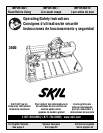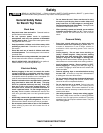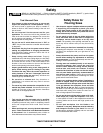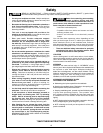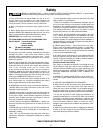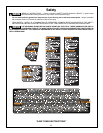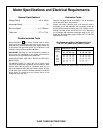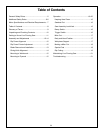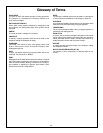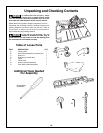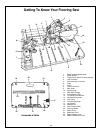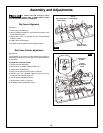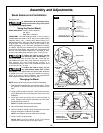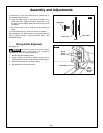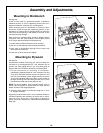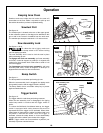
2Using a Push Stick for ripping widths of 1-3/4" to 6" and
u
sing a piece of scrap wood to push the workpiece to
complete the ripping operations when ripping width is too
narrow (less than 1-3/4”) to allow the use of a push stick.
3NOT confining the cut-off piece when ripping or cross -
cutting.
4When ripping, apply the feed force to the section of the
workpiece between the sawblade and the rip fence. Use Push
Stick or scrap wood when appropriate (See item f. above).
"$!&&! Eyes, hands, face, ears and body.
&!(! "' &!&%" &!!
! !&)$ ;;?15@@5:38;B1?
;;?18;@45:3
1/7@511C18>E
! &! $
$!! %(%!(!)%
-If any part of your saw is missing, malfunctioning, has been
damaged or broken … such as the motor switch, or other
operating control, a safety device or the power cord … cease
operating immediately until the particular part is properly
repaired or replaced.
.Wear safety goggles and a face shield if operation is dusty.
Wear ear plugs or muffs during extended periods of operation.
Small loose pieces of wood or other objects that contact the
rear of the revolving blade can be thrown back
at the operator at excessive speed. This can usually be
avoided by keeping the guard and spreader in place for all
“THRU-SAWING” operations (sawing entirely thru the work)
AND by removing all loose pieces from the table with a long
stick of wood IMMEDIATELY after they are cut off.
/NEVER turn the saw “ON” before clearing the table of all
tools, wood scraps, etc., except the workpiece and related
feed or support devices for the operation planned.
0NEVER place your face or body in line with the cutting tool.
GNEVER place your fingers and hands in the path of the
sawblade or other cutting tool.
GNEVER reach in back of the cutting tool with either hand to
hold down or support the workpiece, remove wood scraps, or
for any other reason. Avoid awkward operations and hand
positions where sudden slip could cause fingers or hand to
move into a sawblade or other cutting tool.
GDO NOT perform any operation “FREEHAND” — always use
the fence to position and guide the work for both rip cuts and
crosscuts.
GNEVER hold onto or touch the “free end” of the workpiece or
a “free piece” that is cut off, while power is “ON” and/or the
sawblade is rotating.
GShut “OFF” the saw and disconnect the power cord when
removing the table insert, changing the cutting tool, or making
adjustments.
GProvide adequate support to the rear and sides of the saw
t
able for wider or long workpieces.
GPlastic and composition (like hardboard) materials may be
cut on your saw. However, since these are usually quite hard
and slippery, the anti-kickback pawls may not stop a kick back.
Therefore, be especially attentive to following proper set-up
and cutting procedures for ripping. Do not stand, or permit
anyone else to stand, in line with a potential kickback.
2 If you stall or jam the sawblade in the workpiece, turn saw
“OFF”, remove the workpiece from the sawblade, and check
to see if the sawblade is parallel to the table slots or grooves
and if the spreader is in proper alignment with the sawblade. If
ripping at the time, check to see if rip fence is parallel with the
sawblade. Readjust as indicated.
3NEVER gang crosscut — lining up more than one work -
piece in front of the blade (stacked vertically, or horizontally
outward on the table) and then pushing thru sawblade. The
blade could pick up one or more pieces and cause a binding
or loss of control and possible injury.
4DO NOT remove small pieces of cut-off material that may
become trapped inside the blade guard while the saw is
running. This could endanger your hands or cause a kick back.
Turn saw “OFF” and wait until blade stops.
!)+!'$'&& &!!%
Dull, gummy or improperly sharpened or set cutting tools can
cause material to stick, jam, stall the saw, or kickback at the
operator. Minimize potential injury by proper cutting tool and
machine maintenance. NEVER ATTEMPT TO FREE A
STALLED SAWBLADE WITHOUT FIRST TURNING THE
SAW OFF.
-NEVER use grinding wheels, abrasive cut-off wheels, fric -
tion wheels (metal slitting blades) wire wheels or buffing
wheels.
.USE ONLY RECOMMENDED ACCESSORIES.
0Make sure the cutting tool rotates in the same direction as
the rotation arrow on the upper guard. Also make sure the
cutting tool, arbor collars and arbor nut are installed pro p erly.
Keep the cutting tool as low as possible for the oper ation
being performed. Keep all guards in place whenever possible.
GDo not use any blade or other cutting tool marked for an
operating speed less than 11,000 R.P.M. Never use a cutting
tool larger in diameter than the diameter for which the saw
was designed. For greatest safety and efficiency when rip ping,
use the maximum diameter blade for which the saw is
designed, since under these conditions the spreader is near -
est the blade.
1Make sure the table insert is flush or slightly below the table
surface on all sides except for rear side. NEVER oper ate the
saw unless the proper insert is installed.
%-21@E
“READ ALL INSTRUCTIONS” — Failure to follow the SAFETY RULES identified by BULLET (•) symbol listed
BELOW and other safety precautions, may result in serious personal injury.
WARNING
!
H%(&% %&$'&! %I



